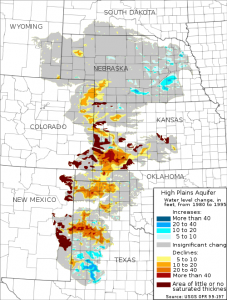If one wanted the Kansas portion of the Ogallala Aquifer to last forever, to be farmable sustainably in perpetuity, one would need to cut back current groundwater mining by 80 percent to bring withdrawals into line with natural recharge, according to a new study published last week in PNAS. That ain’t gonna happen. But even a 20 percent reduction in pumping could stretch out the peak of agricultural production to 2070, according to David Steward of Kansas State University and his colleagues.
Reducing pumping now to stretch out their supplies for future generations is an important community question, as Brett Walton explains in a nice piece on the study and its implications:
The allure of heritage is powerful in this deeply agricultural land. Farms here run in the family, often for generations. Testifying last November in favor of the voluntary reductions in northwest Kansas, Roche Meier, a Sheridan County farmer who would be affected by the cuts, told a state water official that the restrictions would be worthwhile if they kept irrigated agriculture alive for his grandchildren.
Reducing pumping by 20 percent might turn out to be less a burden than feared, for several reasons. More crop production with less water is possible thanks to water-efficient technologies such as center-pivot and drip irrigation, varieties of corn selected to endure drier conditions, and farming techniques that maximize water use. The goal for each strategy is to ensure that each drop of water applied to a crop is put to use by the plant. The study found that this measure, called water-use efficiency, has increased by roughly 2 percent every year.


Pingback: Another Week of Climate Instability News, September 1, 2013 – A Few Things Ill Considered
Pingback: How long before the Midwest runs out of water?
John, congrats on the mention and link in the Wash Post:
http://www.washingtonpost.com/blogs/wonkblog/wp/2013/09/12/how-long-before-the-midwest-runs-out-of-water/